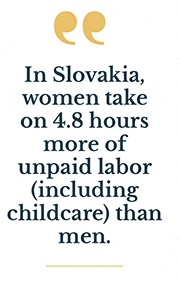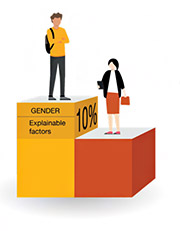Legislative requirements
Looking at over half of the OECD countries, we can see an emergence of legislative requirements that are motivating companies to track their gender pay gap.2 The type of gender pay gap monitored by countries is often defined as the difference between the average earnings of men and women expressed as a percentage of the average earnings of men.3 It is therefore a rather straightforward indicator of inequality in pay between the genders that can be calculated by companies of any size and across all industries, making it a popular option with policy makers.
Unadjusted gender pay gap
Since it is a comparison of the wages of all men and all women, the gender pay gap, despite being easy to calculate, incorporates various factors that affect pay differences between genders into one indicator. These factors can in majority be represented by skills, education, experience, age, seniority, location, number of children, and gender. Furthermore, they also include potential gender discrimination in terms of “unequal pay for equal work”, as well as underlying differences in the behaviors of men and women in the labor market.4 By incorporating various factors into one calculation without adjustments, it is also called the “unadjusted gender pay gap”.
 However, it is still necessary to account for these factors and adjust the findings accordingly. This is why some legislation requires that the unadjusted gender pay gap is assessed not only for the whole company, but for key employee categories as well. In the pay transparency directive, for example, the employee categories are determined based on non-discriminatory job categories including skills, effort, responsibility, and working conditions.5 While such an assessment of job roles eliminates discrimination of pay for work of equal value, it still does not successfully highlight other significant factors that influence the unadjusted gender pay gap.
However, it is still necessary to account for these factors and adjust the findings accordingly. This is why some legislation requires that the unadjusted gender pay gap is assessed not only for the whole company, but for key employee categories as well. In the pay transparency directive, for example, the employee categories are determined based on non-discriminatory job categories including skills, effort, responsibility, and working conditions.5 While such an assessment of job roles eliminates discrimination of pay for work of equal value, it still does not successfully highlight other significant factors that influence the unadjusted gender pay gap.
The motherhood penalty
The most significant factor that is driving the unadjusted gender pay gap is the loss of lifetime earnings experienced by women that are raising children - also known as the motherhood penalty.1 It is initially driven by the “sticky floors” phenomenon, which is the slower career progression that women experience after their return to work from paternity leave. The motherhood penalty is however further perpetuated by the uneven share of childcare in hours that women take on. In Slovakia, women take on 4.8 hours more of unpaid labor (including childcare) than men.6 Such factors, while to an extent explaining the existence of the gender pay gap, are difficult to assess through job categories, since they are not related to job descriptions but to deeper underlying gender differences in behaviors and societal expectations placed on women and men.
Adjusted gender pay gap
To assess such explainable factors of the unadjusted gender pay gap as well as the relationship between gender and pay, isolated from all other factors that might influence it, we can use the adjusted gender pay gap, also known as the equal pay gap. The adjusted gender pay gap is calculated using regression analysis. This type of analysis can show us if gender is a relevant factor that has influence on the pay difference between men and women. This makes regression analysis a versatile and sophisticated method for analyzing pay gaps and provides deeper insights into your pay structures and the intricate motivations behind them.
 However, the calculation of the adjusted gender pay gap is more complex, making it more difficult to communicate to a wider audience and implement on a national scale.7 It is also important to consider the size of the company, since a regression analysis can only be applied to companies with a higher number of employees, in order to provide trustworthy insights.
However, the calculation of the adjusted gender pay gap is more complex, making it more difficult to communicate to a wider audience and implement on a national scale.7 It is also important to consider the size of the company, since a regression analysis can only be applied to companies with a higher number of employees, in order to provide trustworthy insights.
The importance of the (un)adjusted gender pay gap
The unadjusted gender pay gap is a complex indicator that, in its calculation, includes a number of factors that influence pay, including culture and societal norms. It is a helpful tool that companies can use to compare themselves to the market and gain valuable initial insights into how they are performing in terms of equal remuneration. Contrastingly, an adjusted gender pay gap, or an equal pay gap, can be used to delve deeper into the unique aspects of what is influencing pay disparities at each specific company.
Equal Pay Day
It is necessary to keep bringing attention to the gender pay gap through events such as Equal Pay Day, which marks the day from which the average woman works for free until the end of the year. The European Commission commemorates this day every year to consistently raise awareness of the existing gender inequalities, and EU countries participate by organizing an Equal Pay Day according to the respective Pay Gap in their country.8 For the year 2023, in Slovakia, this day fell on the first of November.6 Let’s do everything in our power to ensure that in the future it falls on the last day of the year.
****
1 PwC’s 2023 Women in Work Index
2 OECD, 2023
3 European parliament, 2023
4 EUROSTAT, 2018
5 Council directive 2023/970
6 IVPR, 2023
7 United Nations, 2019
8 European commision, 2023
Lucia Glasová, People Sustainability Manager, PwC Slovakia
Ema Srnáková, People Sustainability Consultant, PwC Slovakia




Follow us